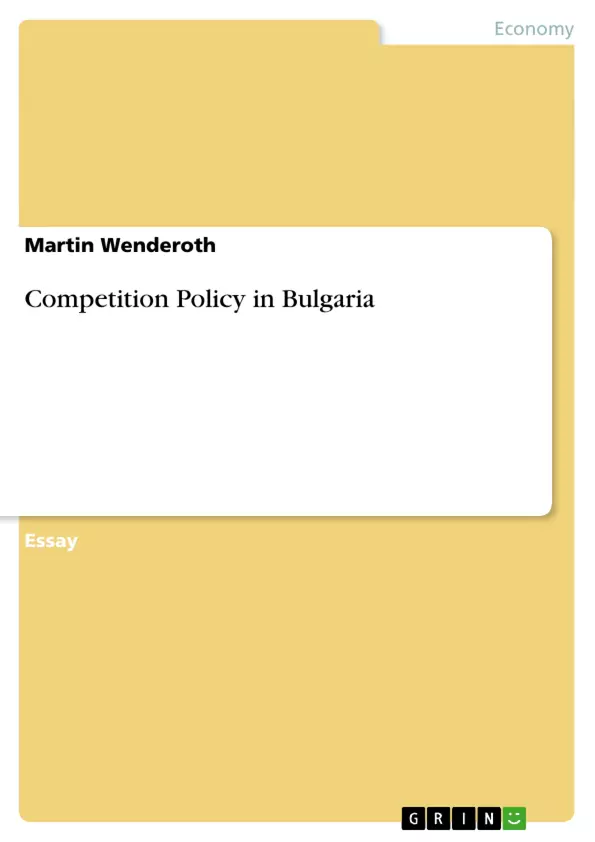Already in the 18th century Adam Smith recognised that the free market system has at least one fault in its construction:
People of the same trade seldom meet together, even for merriment and diversion, but the conversation ends in a conspiracy against the public, or in some contrivance to raise prices. It is impossible indeed to prevent such meetings, by any law which either could be executed, or would be consistent with liberty and justice. (Adam Smith, 2007)
In order to overcome what Adam Smith called a “conspiracy against the public”, countries or groups of countries, such as the European Union, make use of the various instruments of competition policy. Through this, the state defines the “laws of the game” and how a breach of such rules will be sanctioned.
The present assignments will explore the measures in the area of competition policy taken by the Republic of Bulgaria. In order to do so, this assignment is divided into four parts. Follow-ing this introduction, restraints of competition, the objectives of competition policy and finally the term competition policy are defined. The third and main part of this assignment will focus on competition policy in Bulgaria. It will start with a brief historical and economical review of Bulgaria, leading over to the development of the national competition policy, mainly after the fall of the “iron curtain” and explore the actual application of the corresponding legislations. Finally, the most important findings and interactions will be summarised and conclusions will be derived.
2. Definitions
2.1. Restraints on competition
With regard to Olten (1998, pp. 155-156), there are three major types of strategies (...)
Inhaltsverzeichnis (Table of Contents)
- 1. Introduction
- 2. Definitions
- 2.1. Restraints on competition
- 2.2. Objectives of competition policy
- 2.3. Competition Policy
- 3. Competition policy in Bulgaria
- 3.1 Historic and Economic Development
- 3.2 Development of Bulgarian Competition Policy
- 3.3 Functioning of the Commission for Protection of Competition
Zielsetzung und Themenschwerpunkte (Objectives and Key Themes)
This assignment explores competition policy measures implemented in the Republic of Bulgaria, particularly post-communist era developments. It analyzes the historical and economic context shaping Bulgarian competition policy, examines the evolution of its legal framework, and details the functioning of the Commission for Protection of Competition (CPC).
- Definition and types of restraints on competition
- Objectives of competition policy, including economic welfare and consumer welfare perspectives
- Historical and economic development of Bulgaria influencing its competition policy
- Evolution of Bulgarian competition law and its alignment with EU regulations
- Structure, powers, and functions of the Commission for Protection of Competition
Zusammenfassung der Kapitel (Chapter Summaries)
Chapter 1: Introduction This chapter introduces the topic of competition policy, referencing Adam Smith's observations on market behavior and outlining the assignment's structure.
Chapter 2: Definitions This section defines key concepts: restraints on competition (collusion, mergers & acquisitions, abusive behavior); objectives of competition policy (economic welfare, consumer welfare, market integration, etc.); and the overall definition of competition policy.
Chapter 3: Competition policy in Bulgaria This chapter, the core of the assignment, begins with a historical and economic overview of Bulgaria, followed by a chronological account of the development of its competition policy, highlighting key legislative milestones and the role of EU accession. The chapter concludes with a detailed examination of the structure, powers, and functioning of the CPC.
Schlüsselwörter (Keywords)
Competition policy, Bulgaria, EU accession, Commission for Protection of Competition (CPC), restraints on competition, collusion, mergers and acquisitions, abusive behavior, economic welfare, consumer welfare, market integration, state aid, Law on Protection of Competition (LPC), macroeconomic stability, foreign direct investment.
- Quote paper
- Dipl.-Kfm. (FH), MBA Martin Wenderoth (Author), 2007, Competition Policy in Bulgaria, Munich, GRIN Verlag, https://www.grin.com/document/122114



